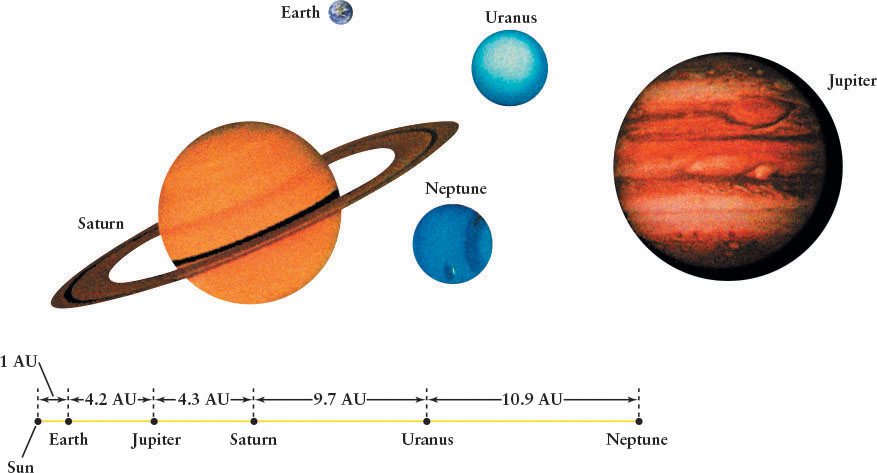Comparative Planetology of the Outer Planets
Now that we have examined the individual outer planets, it is instructive to compare their various properties. Table 8-1 The Outer Planets: A Comparison summarizes much of this material.
| Interior | Surface | Rings | Atmosphere | Magnetic Field* | |
|---|---|---|---|---|---|
| Jupiter | Terrestrial core, liquid metallic hydrogen shell, liquid hydrogen mantle | No solid surface, atmosphere gradually thickens to liquid state, belt and zone structure, hurricane-like features | Yes | Primarily H, He | 19,000 × Earth’s total field; at its cloud layer, 14 × Earth’s surface field |
| Saturn | Similar to Jupiter, with bigger terrestrial core and less metallic hydrogen | No solid surface, less distinct belt and zone structure than Jupiter | Yes | Primarily H, He | 570 × Earth’s total field; at its cloud layer, ⅔ × Earth’s surface field |
| Uranus | Terrestrial core, liquid water shell, liquid hydrogen and helium mantle | No solid surface, weak belt and zone system, hurricane-like features, color from methane absorption of red, orange, yellow | Yes | Primarily H, He, some CH4 | 50 × Earth’s total field; at its cloud layer, 0.73 × Earth’s surface field |
| Neptune | Similar to Uranus | Similar to Uranus | Yes | Primarily H, He, some CH4 | 35 × Earth’s total field; at its cloud layer, 0.4 × Earth’s surface field |
| For detailed numerical comparisons between planets, see Appendix Tables E-1 and E-2. | |||||
| *To see the orientations of these magnetic fields relative to the rotation axes of the planets, see Figure 8-37. | |||||

|
|||||
Size and Mass
The four giant planets, Jupiter, Saturn, Uranus, and Neptune, are all much larger (roughly 4 to 11 times Earth’s diameter) and more massive (roughly 14 to 318 times Earth’s mass) than Earth.
Atmospheres and Rotations
The four outer planets have thick hydrogen- and helium-rich atmospheres that are permanently and completely covered with clouds. All of the giant planets rotate rapidly compared to Earth. Their sidereal rotation rates range from about 10 hours to about 17¼ hours. This rapid rotation draws their clouds into parallel bands, called belts and zones. Earth’s slower rotation allows the clouds and winds here to roam over a much greater range of latitudes than on the giant planets.
Interiors
All four giant planets have terrestrial bodies as their cores. That is where their internal similarities to Earth end. The cores of Jupiter and Saturn are surrounded by thick liquid metallic hydrogen layers, which, in turn, are surrounded by layers of normal hydrogen and helium. Calculations suggest that Jupiter’s core is being dissolved by the interaction of its iron with its surrounding liquid metallic hydrogen. In contrast, Uranus and Neptune’s terrestrial cores are surrounded by large amounts of water, which, in turn, are surrounded by liquid hydrogen and helium.
268
Magnetic Fields and Rings
Margin Question 8-16
Question
How do the numbers and types of moons found orbiting the giant planets compare to those that orbit the terrestrial planets?
The four giant planets all have magnetic fields that store particles from the solar wind, similar to Earth’s Van Allen belts. Like Earth’s magnetic field, those of Jupiter, Uranus, and Neptune are tilted relative to their rotation axes. Saturn’s magnetic field is along its rotation axis. The four giants all have rings. Saturn’s rings are the most massive and distinctive, followed by those of Uranus, Jupiter, and Neptune.
269
Moons
Among them, the giant planets have at least 169 moons. Each of the giants has between one and a few spherical moons, like our Moon. However, most of the moons in the solar system are much smaller, irregularly shaped bodies. These objects are most likely captured space debris. Unlike our Moon, all of the satellites of the giants are at least a few hundred thousand times less massive than their planets. Indeed, most moons are millions or billions of times less massive than their planets. Recall that our Moon is only 81 times less massive than Earth.
8-18 Frontiers yet to be discovered
The outer planets hold countless new insights into the formation and evolution of the solar system. Considering that most of the known extrasolar planets are Jupiterlike gas giants, our outer planets also have a lot to tell us about planets throughout our Galaxy. Some specific issues include: What are the details of the dynamics that create their belts and zones? How has the Great Red Spot persisted for so long? Is Jupiter’s core dissolving? Is there life in the underground oceans of the outer Galilean moons? What, exactly, do the individual ring particles around each of the planets look like? How long ago did Saturn’s ring system form? How long will it last? Are the moving spokes in Saturn’s rings really caused by its magnetic field, and if they are, why do the spokes appear as they do? What caused Miranda’s surface to become so profoundly disturbed? These are but a few of the questions about the outer planets that are likely to be answered during this century.